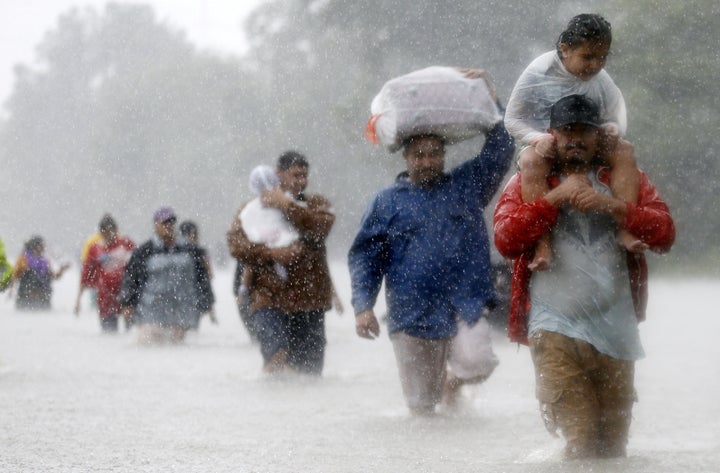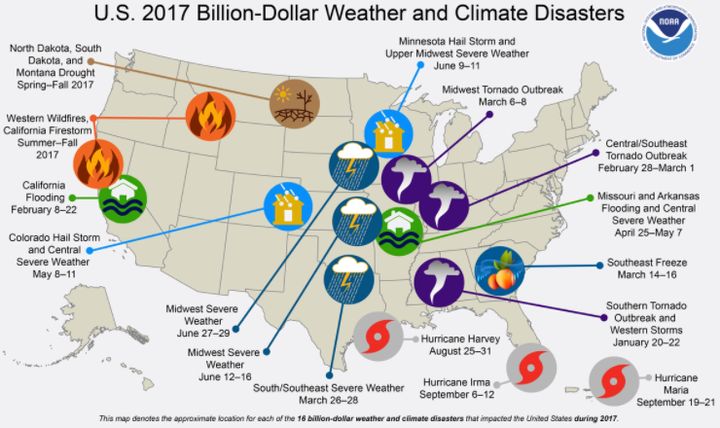The nation’s third-hottest year on record is now officially its costliest for billion-dollar natural disasters.
Sixteen major climate- and weather-related catastrophes caused a record $306.2 billion in damages and killed at least 362 people in 2017 as the United States suffered its worst wildfire and hurricane seasons in modern history, according to a report released Monday by the National Oceanic and Atmospheric Administration.
Hurricanes created the most damage, totaling $265 billion as Hurricanes Harvey, Maria and Irma racked up a respective $125 billion, $90 billion and $50 billion. Wildfires caused $18 billion in losses, tripling previous annual records.
The new tally shattered the previous 2005 record of $215 billion, driven mostly by Hurricanes Katrina, Wilma and Rita. Hurricane Harvey, which made landfall over Houston in late August, is second only to Katrina in for record billion-dollar disasters.
“2017 was a historic year for billion-dollar weather and climate disasters,” Adam Smith, an climatologist at NOAA, said on a call with reporters.
Climate change has made weather events more destructive, with fiercer, more violent storms and prolonged droughts that transformed swaths of the west into tinderboxes, driving up the losses. But part of the problem is that more valuable properties are located on the coasts or near forests. NOAA officials said the analysis did not account for differences between those two factors.

“For the purposes especially of this product, we do not try to parse those apart,” Deke Arndt, chief of the monitoring section at NOAA’s National Centers for Environmental Information, said on a call with reporters. “We’re more interested in quantifying what’s going on. Both the economists and physical scientists will retrospectively look at that, but those sort of happen at the speed of science.”
But the cost and death tolls are expected to climb as new data on Puerto Rico’s post-hurricane destruction emerge. The official body count after Hurricanes Maria and Irma ransacked the island territory and destroyed its electrical grid sits at 64, but an analysis by The New York Times pegged the figure at 1,052, and climbing.
“We will update the number when that number becomes available, which could be substantially higher,” Jake Crouch, a climate scientist at the National Centers for Environmental Information, said on the call.
Even with more accurate data, the report only offers a glimpse at the devastation caused by the disasters.

“We do not take into account things like health care-related costs, destruction of natural capital, physical and mental distress,” Crouch said. “It could be stated that these costs are to the best of our ability but they are really a low point to the true total cost.”
The findings mirror larger global trends. Natural disasters cost insurance companies a record $135 billion in 2017, according to figures released last week by Munich Re, the world’s largest reinsurer. Counting uninsured losses, that figure climbed to $330 billion. The only costlier year was 2011, when the Tohoku earthquake in Japan contributed to a total of $354 billion. Disasters in the U.S. made up 50 percent of this year’s losses, the German company said, compared to 32 percent on average years.
The catastrophes came during a third consecutive year of above-average annual temperatures across the contiguous U.S. and Alaska, the NOAA report found. (Hawaii also saw record temperatures, but was not included in the report).
Five states ― Arizona, Georgia, New Mexico, North Carolina and South Carolina ― experienced their warmest year on record. Annual temperatures in another 32 states, including Alaska, ranked among the 10 warmest years on record.


